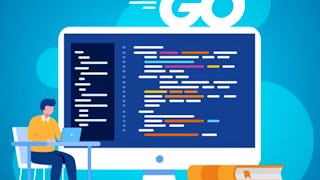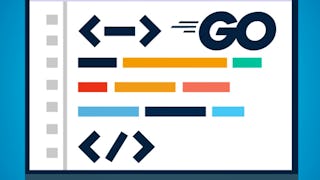Learn how to implement concurrent programming in Go. Explore the roles of channels and goroutines in implementing concurrency. Topics include writing goroutines and implementing channels for communications between goroutines. Course activities will allow you to exercise Go’s capabilities for concurrent programming by developing several example programs.


Concurrency in Go
This course is part of Programming with Google Go Specialization

Instructor: Ian Harris
27,871 already enrolled
Included with
(790 reviews)
Skills you'll gain
Details to know

Add to your LinkedIn profile
See how employees at top companies are mastering in-demand skills

Build your subject-matter expertise
- Learn new concepts from industry experts
- Gain a foundational understanding of a subject or tool
- Develop job-relevant skills with hands-on projects
- Earn a shareable career certificate

There are 4 modules in this course
This course introduces the concept of concurrency in Go. The first module sets the stage by reviewing the physical factors that can restrict microprocessor performance increases in the future.
What's included
2 videos5 readings1 assignment1 peer review
This module looks at basic concurrency concepts and race conditions in preparation for a discussion of threads coming up in the next module.
What's included
2 videos5 readings1 assignment1 peer review
In this module, you’ll work with threaded goroutines and explore the benefits of synchronization. The week’s assignment has you using a threaded approach to create a program that sorts integers via four separate sub-arrays, then merging the arrays into a single array.
What's included
3 videos7 readings1 assignment1 peer review
This last module ties together the various features – including threads, concurrency, and synchronization – covered in this course. The week’s programming assignment requires you to use concurrent algorithms in the implementation of the “dining philosopher’s problem and then address the ensuing synchronization issues.
What's included
3 videos8 readings1 assignment1 peer review
Earn a career certificate
Add this credential to your LinkedIn profile, resume, or CV. Share it on social media and in your performance review.
Instructor

Offered by
Explore more from Software Development
 Status: Free Trial
Status: Free Trial Status: Free Trial
Status: Free TrialEdureka
Why people choose Coursera for their career




Learner reviews
790 reviews
- 5 stars
76.83%
- 4 stars
16.70%
- 3 stars
3.54%
- 2 stars
1.51%
- 1 star
1.39%
Showing 3 of 790
Reviewed on Feb 12, 2023
Perfect explanation of the subject and very good activities that tests your knowledge and understating of the topics.
Reviewed on Jan 29, 2020
Really helpful to understand and implement concurrent process in golang. Its clear my concept and idea about concurrency. Thanks again
Reviewed on Jan 9, 2022
week 3 assignment needs a thorough review cause it lacks clarity ! week 2 assignment is also barely consistent with the related course (i.e week2)

Open new doors with Coursera Plus
Unlimited access to 10,000+ world-class courses, hands-on projects, and job-ready certificate programs - all included in your subscription
Advance your career with an online degree
Earn a degree from world-class universities - 100% online
Join over 3,400 global companies that choose Coursera for Business
Upskill your employees to excel in the digital economy
Frequently asked questions
To access the course materials, assignments and to earn a Certificate, you will need to purchase the Certificate experience when you enroll in a course. You can try a Free Trial instead, or apply for Financial Aid. The course may offer 'Full Course, No Certificate' instead. This option lets you see all course materials, submit required assessments, and get a final grade. This also means that you will not be able to purchase a Certificate experience.
When you enroll in the course, you get access to all of the courses in the Specialization, and you earn a certificate when you complete the work. Your electronic Certificate will be added to your Accomplishments page - from there, you can print your Certificate or add it to your LinkedIn profile.
Yes. In select learning programs, you can apply for financial aid or a scholarship if you can’t afford the enrollment fee. If fin aid or scholarship is available for your learning program selection, you’ll find a link to apply on the description page.
More questions
Financial aid available,
¹ Some assignments in this course are AI-graded. For these assignments, your data will be used in accordance with Coursera's Privacy Notice.



